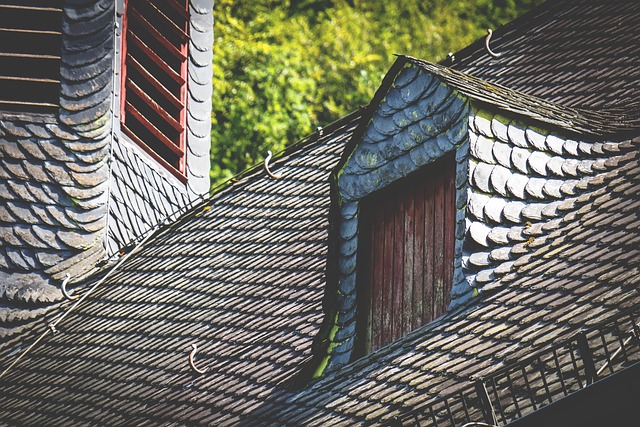In today's environmentally conscious world, composite shingles stand out as a superior eco-friendly roofing solution. Crafted from recycled materials and innovative binders, these shingles offer exceptional strength, longevity, low maintenance, and enhanced energy efficiency. They are ideal for both residential and commercial use, promoting structural integrity while minimizing environmental impact. With proper installation and ongoing maintenance, composite shingles extend roof lifespans, reduce waste, and significantly lower carbon footprints compared to traditional roofing options. Driven by growing ecological awareness and stricter building regulations, the market shift towards eco-friendly roofing solutions like composite shingles is evident, with future innovations promising even better performance and aesthetics.
Looking for a lightweight, durable, and eco-conscious roofing solution? Composite shingles are revolutionizing the way we think about roofs. This article delves into the world of composite shingles, exploring their unique composition and manufacturing process. We’ll highlight their numerous benefits, from reduced environmental impact to superior strength. Additionally, we’ll discuss installation, maintenance, and current market trends, offering a comprehensive guide to this sustainable roofing option.
Understanding Eco-Friendly Roofing: The Need for Sustainable Solutions
In today’s world, where environmental consciousness is on the rise, there is a growing need for sustainable and eco-friendly solutions in every aspect of life—including roofing. Eco-friendly roofing refers to using materials and practices that minimize the environmental impact during manufacturing, installation, and throughout the roof’s lifespan. The traditional roofing options often involve resource-intensive materials, contributing to significant amounts of waste and carbon emissions. As a result, there is an increasing demand for lightweight and durable alternatives that offer both functionality and environmental stewardship.
Composite shingles, made from a blend of recycled materials and innovative binders, present a compelling option for eco-friendly roofing. These shingles not only reduce the reliance on virgin resources but also provide exceptional strength and longevity, outperforming traditional asphalt shingles in various aspects. By choosing composite shingles, homeowners and builders can contribute to a greener planet while enjoying the benefits of low maintenance, enhanced aesthetic appeal, and improved energy efficiency.
Introduction to Composite Shingles: Material and Manufacturing Process
Composite shingles are a cutting-edge alternative in the roofing industry, offering both durability and lightweight properties that traditional shingles often lack. These innovative materials are crafted by combining high-quality plastics with natural fibers, creating a robust and sustainable option for eco-friendly roofing. The manufacturing process involves advanced technology to fuse these components into a seamless, uniform product.
By harnessing the power of modern material science, composite shingles can withstand extreme weather conditions, from powerful storms to intense sun exposure. Their lightweight design reduces the strain on structural supports, making them an ideal choice for both residential and commercial buildings. This innovative approach to roofing not only ensures longevity but also contributes to environmental sustainability, as these materials often include recycled content and are fully recyclable at the end of their useful life.
Benefits of Composite Shingles: Lightweight, Durable, and Eco-Conscious
Composite shingles offer a compelling option for homeowners seeking a lightweight and durable roofing solution that also aligns with their eco-conscious values. One of the key advantages is their weight—significantly lighter than traditional asphalt shingles—which reduces the structural load on buildings, potentially lowering repair or replacement costs down the line. This feature is particularly beneficial in regions prone to heavy storms and strong winds.
Moreover, composite shingles are incredibly durable. Crafted from a blend of recycled materials and advanced polymers, they withstand extreme weather conditions, including high winds, hailstorms, and intense sunlight, better than their asphalt counterparts. Their longevity not only saves homeowners from frequent replacements but also contributes to a reduced environmental impact, as less waste ends up in landfills. This eco-friendly roofing option is a win for both properties and the planet.
Installation and Maintenance: Ensuring Longevity and Performance
Installation and maintenance play a pivotal role in ensuring the longevity and optimal performance of composite shingles. These shingles, known for their lightweight yet durable nature, offer an eco-friendly roofing solution that requires relatively straightforward installation compared to traditional materials. The process involves proper alignment and attachment to the roof deck, with specific attention given to flashing and sealing around fixtures for water tightness.
Regular maintenance is crucial to preserving the aesthetic appeal and structural integrity of composite shingles. This includes routine inspections to identify any signs of damage or wear, prompt repair or replacement of damaged shingles, and keeping the roof free from debris buildup. Simple cleaning with mild soap and water can help maintain their appearance, while professional cleaning and maintenance services can be scheduled as needed to guarantee the sustained performance of your eco-friendly roofing system.
Market Trends and Future Outlook: Popular Choices and Innovations in Composite Roofing
The market for composite shingles is experiencing a significant shift towards eco-friendly roofing solutions, driven by increasing environmental awareness and stringent building regulations. Consumers are increasingly opting for sustainable alternatives that offer both durability and lightweight properties, making composite shingles a popular choice. These shingles are made from recycled materials, reducing the carbon footprint associated with traditional roofing options.
Looking ahead, the future of composite roofing looks promising with ongoing innovations aimed at enhancing performance and aesthetics. Manufacturers are investing in advanced technologies to create shingles that mimic the look of natural materials like wood or slate while offering superior longevity and resistance to extreme weather conditions. As the demand for green building practices continues to rise, composite roofing is poised to play a pivotal role in shaping the future of eco-friendly and durable housing solutions.
Composite shingles emerge as a leading candidate for eco-friendly roofing, offering a sustainable solution without compromising durability. Their lightweight nature reduces material and transportation emissions, while their long lifespan lowers maintenance costs. As consumer demand for green alternatives grows, advancements in composite manufacturing will only enhance their appeal. Embracing these innovative materials is not just an environmentally conscious choice but also a smart investment for any property owner looking to future-proof their home.
